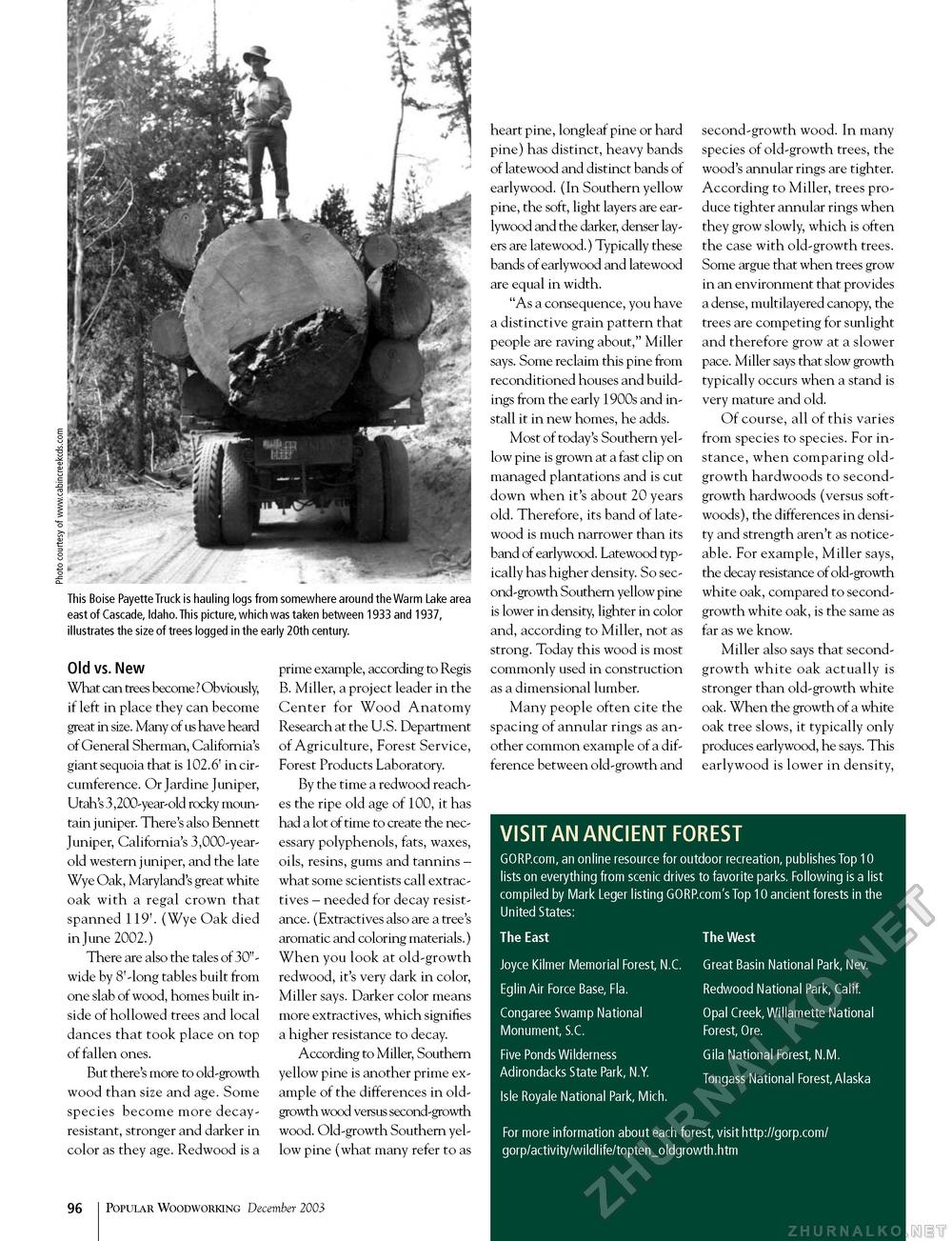Popular Woodworking 2003-12 № 138, страница 95
This Boise Payette Truck is hauling logs from somewhere around the Warm Lake area east of Cascade, Idaho. This picture, which was taken between 1933 and 1937, illustrates the size of trees logged in the early 20th century. Old vs. New What can trees become? Obviously, if left in place they can become great in size. Many of us have heard of General Sherman, California's giant sequoia that is 102.6' in circumference. Or Jardine Juniper, Utah's 3,200-year-old rocky mountain juniper. There's also Bennett Juniper, California's 3,000-year-old western juniper, and the late Wye Oak, Maryland's great white oak with a regal crown that spanned 119'. (Wye Oak died in June 2002.) There are also the tales of 30"-wide by 8'-long tables built from one slab of wood, homes built inside of hollowed trees and local dances that took place on top of fallen ones. But there's more to old-growth wood than size and age. Some species become more decay-resistant, stronger and darker in color as they age. Redwood is a prime example, according to Regis B. Miller, a project leader in the Center for Wood Anatomy Research at the U.S. Department of Agriculture, Forest Service, Forest Products Laboratory. By the time a redwood reaches the ripe old age of 100, it has had a lot of time to create the necessary polyphenols, fats, waxes, oils, resins, gums and tannins -what some scientists call extractives - needed for decay resistance. (Extractives also are a tree's aromatic and coloring materials.) When you look at old-growth redwood, it's very dark in color, Miller says. Darker color means more extractives, which signifies a higher resistance to decay. According to Miller, Southern yellow pine is another prime example of the differences in old-growth wood versus second-growth wood. Old-growth Southern yellow pine (what many refer to as heart pine, longleaf pine or hard pine) has distinct, heavy bands of latewood and distinct bands of earlywood. (In Southern yellow pine, the soft, light layers are ear-lywood and the darker, denser layers are latewood.) Typically these bands of earlywood and latewood are equal in width. "As a consequence, you have a distinctive grain pattern that people are raving about," Miller says. Some reclaim this pine from reconditioned houses and buildings from the early 1900s and install it in new homes, he adds. Most of today's Southern yellow pine is grown at a fast clip on managed plantations and is cut down when it's about 20 years old. Therefore, its band of late-wood is much narrower than its band of earlywood. Latewood typically has higher density. So second-growth Southern yellow pine is lower in density, lighter in color and, according to Miller, not as strong. Today this wood is most commonly used in construction as a dimensional lumber. Many people often cite the spacing of annular rings as another common example of a difference between old-growth and second-growth wood. In many species of old-growth trees, the wood's annular rings are tighter. According to Miller, trees produce tighter annular rings when they grow slowly, which is often the case with old-growth trees. Some argue that when trees grow in an environment that provides a dense, multilayered canopy, the trees are competing for sunlight and therefore grow at a slower pace. Miller says that slow growth typically occurs when a stand is very mature and old. Of course, all of this varies from species to species. For instance, when comparing old-growth hardwoods to second-growth hardwoods (versus softwoods), the differences in density and strength aren't as noticeable. For example, Miller says, the decay resistance of old-growth white oak, compared to second-growth white oak, is the same as far as we know. Miller also says that second-growth white oak actually is stronger than old-growth white oak. When the growth of a white oak tree slows, it typically only produces earlywood, he says. This earlywood is lower in density, VISIT AN ANCIENT FOREST GORP.com, an online resource for outdoor recreation, publishes Top 10 lists on everything from scenic drives to favorite parks. Following is a list compiled by Mark Leger listing GORP.com's Top 10 ancient forests in the United States: The East Joyce Kilmer Memorial Forest, N.C. Eglin Air Force Base, Fla. Congaree Swamp National Monument, S.C. Five Ponds Wilderness Adirondacks State Park, N.Y. Isle Royale National Park, Mich. The West Great Basin National Park, Nev. Redwood National Park, Calif. Opal Creek,Willamette National Forest, Ore. Gila National Forest, N.M. Tongass National Forest,Alaska For more information about each forest, visit http://gorp.com/ gorp/activity/wildlife/topten_oldgrowth.htm 96 108 Popular Woodworking December 2003 |








